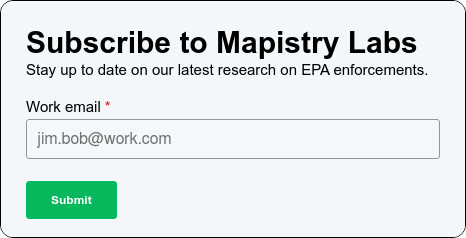Clean Air Act penalties in manufacturing - Mapistry Labs #3
Welcome back to Mapistry Labs, where we make EPA enforcement data easy for environmental teams to understand.
In our last edition, we analyzed Clean Air Act (CAA) penalties and found that the manufacturing sector was particularly affected by increasing enforcement and penalties.
In this report, we'll examine subsectors within the manufacturing industry to understand who is getting hit with enforcements.
Don’t want to get fined? Stay compliant in less time with Mapistry's environmental software.
Executive summary
- The oil industry was the top CAA offender in 2023, especially when considering the number of enforcement actions relative to its industry size.
- Primary metal, nonmetallic mineral, and paper manufacturing are the next-closest offenders.
- Since 2014, fifteen out of twenty manufacturing subsectors saw an increase in average penalty payments.
For industry definitions, please review the Census website. If you’d like to share our charts, you can download them here.
Oil and chemical industries are the top Clean Air Act offenders in manufacturing
The petroleum products manufacturing industry (which we’ll refer to as the oil industry) absolutely stands out when it comes to NOVs. With a total of 1,410 NOVs issued in 2023, it received almost twice as many NOVs as the chemical industry, which came in second.
For CAA penalties, it was a tight race for first place. The chemical industry received the most penalties (231), followed by oil (227). Far behind in third place was the nonmetallic mineral products industry with 137 penalties - 40% fewer penalties than the top two.
Now, we don’t know if that’s just because manufacturing, mining, and utilities are the biggest industries. The biggest industry could see more action because there are more businesses, right?
Oil with extremely high enforcement density
If you read our last report, you might remember the extremely high penalty density (=penalties per 100,000 businesses) in the mining industry compared to other industries.
Within the manufacturing industry, there’s a similar story. When comparing the number of NOVs per 100,000 businesses, the oil industry received over eight times more NOVs (33,652) than the second-highest offender, primary metal products (4,054), and almost 14 times more than the manufacturing average.
Industries like computer and electronics, leather, and apparel manufacturing received the fewest NOVs relative to the number of businesses in their subsector.
The reason behind these numbers
The high penalty density and number of Notices of Violation (NOVs) in industries like mining and oil may be due to stringent regulatory scrutiny, inherent environmental risks, and the large scale of their operations. These sectors often involve processes that can cause significant environmental damage, such as drilling, mining, and refining, which could lead to more frequent violations and a higher number of NOVs.
Regulatory agencies might impose stricter compliance standards on high-risk industries due to their environmental impact, resulting in more inspections and enforcement actions. However, the use of older technologies and less efficient processes in these industries can also play a significant role in contributing to higher rates of non-compliance.
Conversely, industries such as computer and electronics, leather, and apparel manufacturing may receive fewer NOVs relative to their size due to having lower environmental risks and less polluting processes, making compliance with environmental regulations easier.
To find the penalty density of your industry, please refer to the chart below.

The average CAA penalty in manufacturing has increased across the board
Rising penalties have been an ongoing story since the beginning of our Mapistry Labs series. The following chart is from our first report, which analyzed penalties across all industries.

It turns out that this trend is the same in the manufacturing industry. Since 2014, fifteen out of twenty manufacturing subsectors saw increased penalties.

The primary metal industry led the pack with an average of $169,858, followed by the oil ($94,965) and chemical ($89,999) industries.
With a decrease of $24,449, the machinery industry saw the most significant decrease in penalty sizes. The lowest penalty payments were recorded in the textile product mills industry ($4,088).
Long-term penalty trends
We also examined long-term trends for the most frequently fined industries: primary metal, oil, chemicals, and paper.
The primary metal and chemical industries have seen a long-term increase in penalty sizes. In the chemical industry, the increase has been consistent except for one five-year period (2009-2013).
While we saw that oil businesses were getting slammed with the absolute and relative NOVs and penalties, their penalty sizes have been much worse in the past, specifically between 1999 and 2008. The same holds true for the paper industry.

The top 3 enforcement cases in oil, metal and chemical industries
Oil: BP
Location: Whiting, IN
Penalty: $31,424,000
Pollutant(s): Benzene
Case summary: (see full details here)
BP has agreed to a consent decree* due to violations related to emissions at its Whiting Refinery. The company failed to meet federal standards for controlling volatile organic compounds and hazardous air pollutants. To address these issues, BP will spend at least $197 million on new engineering reviews, enhanced monitoring, and installing new controls to reduce emissions. They will also pay a $40 million penalty and invest $5 million in additional environmental projects. The State of Indiana is involved as a co-plaintiff in this agreement.
Metal: Globe Metallurgical, Inc.
Location: Waterford, OH
Penalty: $2,600,000
Pollutant(s): Particulate matter (PM 10), sulfur dioxide
Case summary: (see full details here)
Globe Metallurgical, Inc. has agreed to a consent decree* to settle alleged Clean Air Act violations at its Ohio facility. The company will pay a $2.6 million penalty and spend about $6.5 million on new air pollution controls and improvements. Globe must also limit the sulfur content of materials used in its metal production to reduce harmful sulfur dioxide emissions. Additionally, the company will build a new pollution control baghouse, improve equipment, and change practices to lower particulate matter emissions. Extensive testing and enhanced monitoring will be conducted to ensure compliance with updated environmental regulations.
Chemical: Altivia Petrochemicals, LLC
Location: Haverhill, OH
Penalty: $1,112,500
Pollutant(s): Volatile organic compounds (VOCs)
Case summary: (see full details here)
The EPA inspected Altivia’s facility in May 2017 and found several violations of air pollution regulations. After years of unsuccessful negotiations, the U.S. government filed a lawsuit against Altivia in October 2021, alleging multiple violations related to emission controls, monitoring, and permit compliance. Under a new consent decree*, Altivia has agreed to implement enhanced measures to detect and repair leaks, conduct annual inspections of certain emissions, and install new emission controls on specific equipment. These actions aim to address the alleged violations and ensure the facility complies with environmental standards moving forward.
*A consent decree is a legal agreement or settlement that resolves a dispute between two parties without admitting guilt or liability.
Methodology
We analyzed the publicly available data from the EPA’s Integrated Compliance Information System for Air (ICIS-Air). For a detailed description of the dataset, please visit the EPA’s website.
We enriched this dataset with NAICS data from naics.com to categorize cases into industries.
We analyzed data using Row Zero and visualized it with the help of Google Sheets and Figma.



%201%20(2).png)

.svg)

